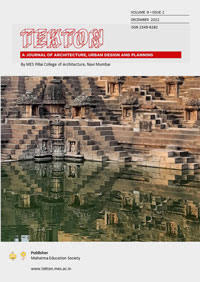Smita Dalvi
Tekton
Volume 9, Issue 2, December 2022
pp. 42-51
 Smita Dalvi teaches architecture and aesthetics in Navi Mumbai and Mumbai for over 25 years. She is a Professor at MES Pillai College of Architecture, Panvel and the editor of Tekton – a scholarly journal of architecture published biannually. She holds a Ph.D. in Design from IIT-Bombay. She is a co-author of ‘Panvel: Great City, Fading Heritage’ (2020) (In English and Marathi). Her research areas are architecture as social history, urban heritage, and cinema studies. Her area of special interest is in Indo-Islamic Art and Architecture, and on this, she has delivered several guest lectures in India and abroad. She is a recipient of the fellowship of ‘Fulbright Visiting Specialist: Direct Access to the Muslim world’.
Smita Dalvi teaches architecture and aesthetics in Navi Mumbai and Mumbai for over 25 years. She is a Professor at MES Pillai College of Architecture, Panvel and the editor of Tekton – a scholarly journal of architecture published biannually. She holds a Ph.D. in Design from IIT-Bombay. She is a co-author of ‘Panvel: Great City, Fading Heritage’ (2020) (In English and Marathi). Her research areas are architecture as social history, urban heritage, and cinema studies. Her area of special interest is in Indo-Islamic Art and Architecture, and on this, she has delivered several guest lectures in India and abroad. She is a recipient of the fellowship of ‘Fulbright Visiting Specialist: Direct Access to the Muslim world’.
smitadalvi@mes.ac.in
ABSTRACT
This paper attempts to focus on Film Architecture, a spectacle of space, as a stylistic device in the two Hindi Devdas films: Sanjay Leela Bhansali’s Devdas (2002) and Anurag Kashyap’s Dev D. (2009) – and its significatory role as a vehicle to convey ideas and themes in the narrative.
Both the films are considered as adaptations and remakes of the 1955 version by Bimal Roy, and make huge stylistic departures from it. Bhansali uses a grandiose, over-the-top style while retaining a semblance of the period narrative of the early 20th century Bengal. Kashyap, on the other hand, relocates the narrative to contemporary India and replacing rural Bengal with rural Punjab and Calcutta with Delhi. He also employs a style that mixes grunge with psychedelia to portray a certain youth culture and the underbelly of Delhi. Both film makers choose cinematic styles that are self-conscious, memorable and impressive. Both create spectacles using cinematic space, albeit very differently, to convey a heightened sense of the tragic.
KEY WORDS
Film Architecture, Spectacle, Hindi Cinema, Devdas


